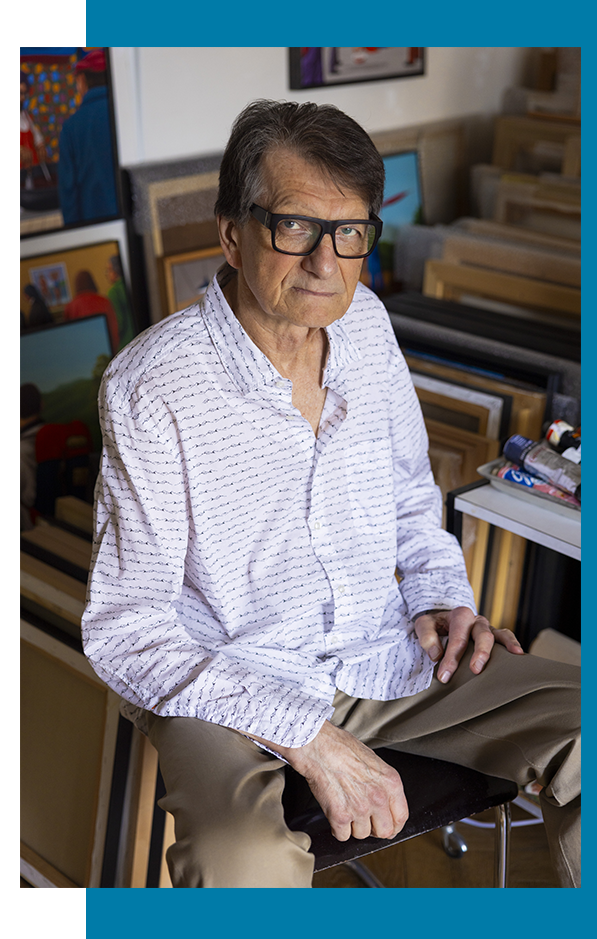Biography
Jan Šafránek was born on April 9, 1948, in Hradec Králové.
It was his grandfather – an amateur painter, photographer, woodcarver, and founder of the post-war puppet theater in Hradec Králové – who introduced him to the world of fine arts in his early childhood. While still attending school, he took painting courses with a local academic painter. Although he initially made his living through various jobs, he remained devoted to drawing and painting. In Hradec Králové, he set up his first studio, where he created narrative figurative paintings using traditional meticulous techniques, inspired by the everyday and banal life of contemporary society.
Since 1970, he has worked as an artist for the Municipal Cinemas in Hradec Králové, where he primarily painted large-scale movie posters. During this time, he held his first solo exhibition in Pardubice. In 1974, he moved to Prague, where he rented and set up a new studio. He gradually established contacts with many Prague artists, mostly from the alternative cultural scene. He took part in various unofficial exhibitions and actively participated in numerous events. He also painted large scenic backdrops for several underground bands, which were later destroyed due to the political circumstances. His paintings from the Prague period offer an ironic commentary on the absurd everyday reality of the normalized society of the 1970s. He depicted scenes from night bars, pubs, diners, various festivities, and other street activities.
After signing Charter 77 and losing his livelihood, he emigrated to Austria in the spring of 1979. In Vienna, he enrolled at the University of Applied Arts (Universität für angewandte Kunst Wien), where he studied for three semesters, focusing mainly on drawing in the studio of Professor Carl Unger. In 1981, he left Europe and settled in Sydney, Australia. In the autumn of that year, he held a solo exhibition at the Hogarth Gallery in Sydney. He also attended graphic workshops in North Sydney, where he focused on printmaking and lithography. In 1984, he was granted Australian citizenship.
In 1985, he traveled throughout the United States and Mexico before settling again in Vienna. From there, he made frequent study trips to Italy. In 1986, he returned once more to Sydney. He traveled extensively throughout Tasmania, New Zealand, the Pacific Islands, Fiji, Tahiti, Easter Island, and South America. From these journeys, he brought back a wealth of drawing material, which he later used as inspiration for his paintings.
In 1990, he returned permanently to Europe, where he has since lived and worked in both Prague and Vienna. He has held numerous solo exhibitions in Europe and overseas and has also participated in many domestic and international exhibitions. His works are represented in both private and public collections in Europe and abroad.
On Šafránek’s Painting Technique
Jan Šafránek, known to the public as a constant portrayer of human morals and immorality, is also a profoundly professional painter who creates his works with uncompromising technical precision. Order and structure form the foundation of his work to a much greater extent than might appear to the untrained eye.
Each painting is based on a “hidden skeleton” of linear drawing construction, tested through series of sketches that serve not only as direct records of real situations but, above all, as the compositional foundation of his paintings. In this context, one cannot help but think of the famous preparatory drawings of Bohumil Kubišta, worked out with mathematical precision down to the last detail, always with a clear idea of the compositional and color elements that would be applied during the gradual layering of oil paints.
Šafránek’s works are thus characterized by an equal union of artistic vision and technical execution. For Jan Šafránek, the painting process is not merely a means of visualizing an initial idea but a creative act in a physical, optical, and meditative sense. When he is not painting directly, he continues to work on the painting in his mind—he says he paints “in his head.”
Richard Drury
(Excerpt from the monographic book Jan Šafránek – The World of People, published by Gallery, Prague, 2008)

